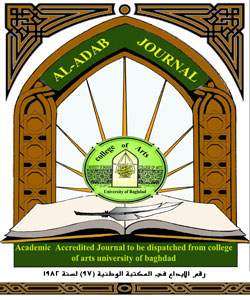نزوح أسر سكان محافظة الأنبار
الوجهة و المشاكل
DOI:
https://doi.org/10.31973/aj.v0i133.904الكلمات المفتاحية:
نزوح، أسر، محافظة، الانبار، الوجهة، المشاكلالملخص
يهدف البحث إلى توضيح ظاهرة النزوح كمشكلة لها تداعيات سلبية من خلال التعرف على عدد أسر محافظة الانبار النازحة داخل العراق و اهم وجهات النزوح في محافظة الانبار و خارجها و اهم المشاكل التي تعاني منها، وتتمثل أهمية البحث في توضيح الطابع الجغرافي لظاهرة النزوح كأزمة سكانية يمر بها العراق عامة ومحافظة الانبار خاصة ، تم الاعتماد على المنهج الوصفي التحليلي في دراسة ظاهرة النزوح من خلال عدد ونسب الأسر النازحة لسكان محافظة الانبار للمدة (2014-2017) وبيان توزيعها الجغرافي على محافظات العراق ، كما تم الاعتماد على نتائج الدراسة الميدانية باستخدام استمارة استبيان في توضيح المشاكل التي عانت منها الأسر النازحة.
توصل البحث إلى العديد من النتائج أهمها :
- وصول المجموع الكلي لأسر محافظة الأنبار النازحة (273356) أسرة للمدة (2014-2017) ، بلغ عددها لعام 2014 (200994) أسرة بنسبة (73.5%) وهي الاعلى مقارنة بنسب الاعوام التي تلتها ،اما ادنى النسب كانت لعام 2017 حيث نزحت (2054) أسرة بنسبة (8%) من المجموع الكلي لأسر محافظة الأنبار النازحة.
- أعلى عدد للأسر النازحة كان للأسر التي نزحت داخل محافظة الانبار اي من مناطق الصراع العسكري الى مناطق اكثر امناٌ ولم تعبر حدود المحافظة بنسبة كبيرة وصلت الى (52.4%) من مجموع الاسر النازحة للمدة (2014-2017) .
- واجهت أسر محافظة الأنبار النازحة العديد من المشاكل منها الامنية ، حيث شكل ضحايا القتل نسبة (12.7%) من حجم العينة المبحوثة, أما نسبة المعتقلين فبلغت (29.5%) ،والمفقودين الذين لا يُعلم مصيرهم فكانت أعلى النسب ب(57.8%).
- عانت أسر محافظة الأنبار النازحة من مشاكل اجتماعية تمثلت في سوء التكيف الاجتماعي في مناطق المستقبلة لهم بنسبة (48%) من حجم العينة المبحوثة ،المشاكل الاقتصادية المتمثلة بالمعاناة مادية هي أكثر معاناة تعرضت لها أسر محافظة الانبار أثناء النزوح بنسبة مرتفعة وصلت الى ( 54%).
- ارتفاع نسبة العاطلين عن العمل ضمن الاسر النازحة بعد النزوح مقارنة بنسبتها قبل النزوح ، إذ ارتفعت من (27%) الى (85%) ، مع انخفاض مستوى الدخل الشهري لدى (74%) من الأسر المبحوثة بعد النزوح الى (اقل 250) الف دينار عراقي وهو لا يسد الحاجة ، أما الأسر التي كان دخلها الشهري(750 -فأكثر) الف دينار عراقي فكانت نسبتها(1%) فقط .
التنزيلات
المراجع
-Allam, Rabeha Saif (2016). The Situation of Refugees and Internally Displaced People in Arab countries. Oman: Arab Women Organization.
-Aldebriz, Geare (B.T.). The city in Developing Countries, translated by Muhammad Mahmoud Al-Johary. Alexandria: House of Knowledge, Alexandria.
-Hammadi, Younis (1985). Principles of Demography. Mosul: Mosul University Press.
-Ismail, Ahmed Ali (1982). The Foundations of Demography and its Geographical Applications, 4th edition, Cairo: B.N.
-Ismail, Khaled and others (2016). The Great Displacement Crisis of the Displaced in Iraq after the ISIS War, 1st F. Baghdad: Beladi Center for Strategic Studies and Research.
-Al-Karim, Manaf Radha (2014). Displacement, Emigration and their Economic and Social Impacts, Baghdad: National Center for Research and Studies.
-Muhammad, Samir Kamel (B.T.). Social Development Basic Concepts "Realistic Vision", Alexandria: The modern University office.
-Al-Najjar, Baqir Suleiman (2001). A dream of Migration for Wealth and Migrant labor in the Arab Gulf, Beirut: Center for Arab Unity Studies.
-Saber, Mohy El-Din (B.T.) Civilization Change and Community Development, Saida: The Modern Library.
-Shwan, Hussein Abdel Hamid Ahmed (1988). The role of social variables in urban development. A Study in Urban Sociology, Alexandria: The Modern University Office.
-Slawi, Abdul Qadir (1979). The Development of the concept of a refugee according to the international documents - Lahay, B.N.
-Mukhlif, Nassif Jasim (2017). Socio-economic Conditions of Families Returning from Displacement, “A Field Study in Al-Anbar Governorate,” Master Thesis (unpublished). University of Baghdad, Iraq.
-Al-Rawi, Mansour Mutni Abdul Karim (1989). Population and Manpower in the Arab Gulf, Journal of Economic and Legal Studies, No. (89), p. 79.
-Al-Saadi, Ahmed Hammoud Muheisen (1997). The Spatial Analysis of the variance of Population Composition in Al-Qadisiyah governorate in the period (1987 -), unpublished doctoral thesis. University of Baghdad, Iraq.
-Tommy, Riad (2005). Tools of Preparation and Construction and the Problem of Development, "Al-Harrush City as a Sample", unpublished Master Thesis, University of Mentouri, Algeria.
-AbdelKhaleq, Ahmed Mohamed (1992). Displacement and its Relations with Personal Dimensions: International Studies, Journal of Social Sciences, Vol. (20), No. (30).
-Al-Amber, Iyad and Isaac Yaqub (2014). The Future of Iraq: A Study of the Relationship between Indicators of a Failed State and the Variables of the State’s Collapse, The Forum’s Yearbook, Volume (1), No. (1).
-Birkland, Nina (2015). Internal Displacement and Global Trends of Conflict-induced Displacement, belonging to the Norwegian Refugee Council, International Journal of the Red Cross, Vol. 19, No. 875.
-Ahmed, Amina (2015). “Education in Iraq - ISIS's grip, and the Size of Displacement,” Kitabat Newspaper, Issue (1256).
-------, Baladi newspaper (2016), “A Report on the Human Suffering of (ISIS) Victims.” Issue (1118).
Governmental Publications:
-General Secretary of the Council of Ministers, Joint Center for Coordination and Monitoring jcmc (2015), Iraq Humanitarian Crisis Report, No. 46,19. Iraq.
-Ministry of Planning and Development Cooperation, Central Statistical Organization (2018). Annual Statistical Group 2017, Iraq.
-Ministry of Planning and Development Cooperation, Central Statistical Organization and Ministry of Immigration and Displaced (2015). National Survey of Internally Displaced Persons in Iraq 2014, Iraq.
-Ministry of Planning and Development Cooperation, Central Statistical Organization (2015), National Survey of Internally Displaced Persons in Iraq for the year 2014, Iraq.
-Amnesty International (2008)., Iraq After Five Years of Massacres and Despair, Iraq.
-Cefahir Center for Civilian Rights and the Group International Minority Rights (2016)., The displacement crisis in Iraq Security and Protection, March 2016, Washington.
-Hamorabi Human Rights Organization (2016)., Field Monitoring, Follow-up, and Documentation on the Human Rights Situation in Iraq, Iraq.
-United Nations, the Economic and Social Commission for Western Asia (ESCWA) (2015). International Immigration Report for West Asia, Beirut, Lebanon.
-United Nations, the High Commission for Human Rights (2014). Internally displaced and migrated persons from 6-10-2014 to 10-5-2015, 2015, Iraq.
International Electronic Reports:
-Iraqi Observatory for Human Rights, (2015), Annual Report "A Year of Sorrow" .. Retrieved from the site:
www.rights-iq.org/en
-Norwegian Council, International Project for internally Displaced and Refugee, retrieved from the website: www.Idpprojet.org
-United Nations, UNHCR (2012), Iraqi Refugee Report "Guidelines, On Internal Displacement", retrieved from the website: www.internal-displacement.org
-United Nations, A report that Iraq is the Third in the World in the Number of Displaced Persons, (2016), retrieved from the website: www.alkuisa.net
التنزيلات
منشور
إصدار
القسم
الرخصة
:حقوق الطبع والنشر والترخيص
بالنسبة لجميع البحوث المنشورة في مجلة الآداب، يحتفظ الباحثون بحقوق النشر. يتم ترخيص البحوث بموجب ترخيص Creative Commons CC BY 4.0 المفتوح ، مما يعني أنه يجوز لأي شخص تنزيل البحث وقراءته مجانًا. بالإضافة إلى ذلك ، يجوز إعادة استخدام البحث واقتباسه شريطة أن يتم الاستشهاد المصدر المنشور الأصلي. تتيح هذه الشروط الاستخدام الأقصى لعمل الباحث وعرضه.
:إعادة إنتاج البحوث المنشورة من الناشرين الآخرين
من الضروري للغاية أن يحصل الباحثون على إذن لإعادة إنتاج أي بحث منشورة (أشكال أو مخططات أو جداول أو أي مقتطفات من نص) لا يدخل في نطاق الملكية العامة أو لا يملكون حقوق نشرها. يجب أن يطلب الباحثون إذنًا من مؤلف حقوق النشر (عادة ما يكون الناشر).
يطلب الإذن في الحالات التالية:
بحوثك الخاصة المنشورة من قِبل ناشرين آخرين ولم تحتفظ بحقوق النشر الخاصة بها.
مقتطفات كبيرة من بحوث أي شخص أو سلسلة من البحوث المنشورة.
استخدم الجداول والرسوم البيانية والمخططات والمخططات والأعمال الفنية إذا لم يتم التعديل عليها.
الصور الفوتوغرافية التي لا تملك حقوق لنشرها.
لا يطلب الإذن في الحالات التالية:
إعادة بناء الجدول الخاص بك مع البيانات المنشورة بالفعل في مكان آخر. يرجى ملاحظة أنه في هذه الحالة يجب عليك ذكر مصدر البيانات في شكل "بيانات من ..." أو "مقتبس من ...".
تعتبر عروض الأسعار القصيرة معقولة الاستخدام العادل ، وبالتالي لا تتطلب إذنًا.
الرسوم البيانية ، الرسوم البيانية ، المخططات ، الأعمال الفنية التي أعاد الباحث رسمها بالكامل والتي تم تغييرها بشكل ملحوظ إلى درجة لا تتطلب الاعتراف.
الحصول على إذن
لتجنب التأخير غير الضروري في عملية النشر ، يجب أن تبدأ في الحصول على أذونات في أقرب وقت ممكن. لا يمكن لمجلة الآداب نشر بحث مقتبس من منشورات أخرى دون إذن.
قد يمنحك مالك حقوق الطبع والنشر تعليمات بشأن شكل الإقرار الواجب اتباعه لتوثيق عمله ؛ بخلاف ذلك ، اتبع النمط: "مستنسخ بإذن من [المؤلف] ، [كتاب / المجلة] ؛ نشره [الناشر] ، [السنة]." في نهاية شرح الجدول ، الشكل أو المخطط.
.jpg)























